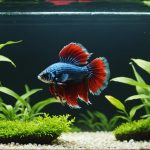Creating an ideal tropical Betta fish tank involves more than just aesthetics. You need to balance the right elements, such as water conditions, tank mates, and decor, to ensure the health and happiness of your Betta. This guide highlights key considerations, from choosing the right tank size to understanding temperature settings. Equip yourself with the essential tips to create a vibrant underwater sanctuary for your Betta, fostering a thriving aquatic environment that reflects the beauty of these stunning fish.
Understanding Betta Fish Needs
Exploring the habitat requirements of betta fish is crucial for their wellbeing. These vibrant creatures originate from the warm, shallow waters of Southeast Asia, where they thrive in rice paddies, ponds, and slow-moving streams. Understanding their natural environment helps in recreating a suitable betta fish habitat at home.
A voir aussi : Essential Guide to Safely Rehabilitating and Releasing Your Rescue Hedgehog into the Wild
Betta Behavior Insights
Understanding betta behavior is key to their care. Bettas are known for their territorial nature and need for space. They prefer environments where they can establish their territory, which helps in reducing stress and promoting natural behaviors. Observing their interactions can provide insights into their health and happiness.
Essential Water Parameters
Maintaining the right water conditions is fundamental for tropical fish care. Bettas require warm water, ideally between 76°F and 82°F, with a pH level ranging from 6.5 to 7.5. Regular monitoring of ammonia, nitrite, and nitrate levels is essential to ensure a safe environment.
Lire également : Essential Guide to Safely Rehabilitating and Releasing Your Rescue Hedgehog into the Wild
- Temperature: 76°F – 82°F
- pH Level: 6.5 – 7.5
- Ammonia: 0 ppm
By focusing on these essential water parameters, betta owners can create a thriving environment, enhancing the fish's natural behavior and overall health.
Choosing the Right Tank Size
Understanding the ideal betta fish tank size is essential for their well-being. A single betta requires a minimum of 5 gallons to thrive. This space allows them to swim freely, reducing stress and promoting natural behaviors. A larger aquarium also helps maintain stable water parameters, crucial for betta health.
Impact on Health and Behavior
Adequate space is vital for betta vitality. A cramped environment can lead to stress, which may cause health issues like fin rot or lethargy. In contrast, a spacious tank encourages exploration and activity, key indicators of a healthy betta. Observing your betta's behavior can offer insights into their comfort and satisfaction with their environment.
Alternatives for Larger Setups
For those considering a community tank, ensure it is at least 10 gallons. This accommodates additional fish while providing ample territory for your betta. Larger setups can include dividers to prevent aggression, allowing multiple bettas to coexist peacefully.
- Single Betta: Minimum 5 gallons
- Community Tank: At least 10 gallons
- Benefits: Reduced stress, improved health, enhanced behavior
By selecting the appropriate tank size, enthusiasts can create a nurturing habitat, fostering both physical and psychological health in their bettas.
Maintaining Optimal Water Conditions
Ensuring betta fish water conditions are ideal is crucial for their health. Regular testing and adjustments help maintain the right aquarium water quality.
Key Water Parameters
Understanding the essential water parameters is vital. Bettas thrive in specific conditions:
- pH Level: 6.5 – 7.5
- Temperature: 76°F – 82°F
- Water Hardness: Soft to moderately hard
Regularly monitoring these aspects ensures a safe and comfortable environment for your betta.
Importance of Regular Testing
Routine water testing is a proactive approach to maintaining aquarium water quality. It helps in identifying any imbalances early, allowing for timely corrections. Consistent testing can prevent issues like stress or disease, ensuring your betta remains healthy.
Utilizing Water Conditioners
To achieve optimal betta fish water conditions, using water conditioners and treatments is beneficial. These products neutralize harmful chemicals and stabilize pH levels, supporting a healthy habitat. Water conditioners are especially useful after water changes, ensuring the new water is safe for your fish.
By focusing on these strategies, you can maintain excellent aquarium water quality, fostering a thriving environment for your betta fish.
Selecting the Proper Filtration System
Choosing the right betta fish filtration system is crucial for maintaining a healthy environment. Bettas are sensitive to strong currents, so selecting an aquarium filter that balances filtration with gentleness is essential.
Types of Filters Suitable for Betta Tanks
Betta fish filtration options vary, with sponge filters being a popular choice due to their gentle flow. Internal filters with adjustable flow rates are also suitable, allowing for customization according to the betta's needs. Hang-on-back filters can be used if they have a flow control feature.
Balancing Filtration with Betta Sensitivity
Bettas thrive in calm waters, so it's important to ensure the aquarium filter does not create strong currents. Opt for filters that allow for flow adjustment, enabling you to set a gentle flow that won't stress your fish.
Maintenance Tips for Filter Systems
Regular maintenance of your betta fish filtration system is vital. Clean or replace filter media as per the manufacturer's instructions to ensure efficiency. A well-maintained filter system helps in removing waste and maintaining water quality, crucial for your betta's health.
- Sponge Filter: Gentle flow, easy maintenance
- Internal Filter: Adjustable flow, compact
- Hang-on-Back Filter: Flow control feature needed
By selecting and maintaining the appropriate aquarium filter, you can create a serene and healthy environment for your betta.
Decorating the Betta Tank
Creating a vibrant and safe environment for your betta fish.
Safe Plants and Materials for Betta Tanks
Betta fish tank decorations should prioritize safety and functionality. Opt for soft, live plants like Java Fern or Anubias, which provide natural filtration and mimic the betta's native habitat. Avoid sharp or rough materials that could damage delicate fins. Silk plants are a safe alternative to plastic ones, offering a gentle touch.
Creating Hiding Spots and Territories
Establishing hiding spots and territories is crucial for a betta's mental health. Use decorations like caves, driftwood, or rocks to create secluded areas. These elements allow bettas to retreat and establish territories, reducing stress and promoting natural behaviors. Ensure all items are aquarium-safe and free from toxins.
Aesthetic Considerations for Betta Habitats
While functionality is key, aesthetic aquarium aquascaping can enhance both the tank's appearance and the fish's wellbeing. Incorporate varied textures and colors to create visual interest and a stimulating environment. Balance open swimming spaces with densely planted areas to cater to the betta's need for exploration and privacy.
- Live Plants: Java Fern, Anubias
- Safe Materials: Silk plants, smooth rocks
- Decor Elements: Caves, driftwood, aquarium-safe decorations
By thoughtfully selecting betta fish tank decorations, you create a harmonious and enriching habitat that supports both the physical and psychological health of your betta.
Choosing Compatible Tank Mates
Exploring options for harmonious community tanks.
Identifying Peaceful Fish Species
Selecting suitable betta fish tank mates is essential for a peaceful aquarium. Consider species known for their calm demeanor, such as corydoras catfish, neon tetras, and harlequin rasboras. These fish typically coexist well with bettas, minimizing conflict and promoting a serene environment.
Avoiding Aggressive or Fin-Nipping Species
To maintain harmony, it's crucial to avoid aggressive fish or those prone to fin-nipping. Species like tiger barbs, serpae tetras, and some gouramis can stress bettas, leading to potential injuries. Prioritize compatibility to ensure a stress-free habitat for all inhabitants.
Introducing New Tank Mates Safely
Proper introduction of new community fish is vital. Gradual acclimatization helps reduce stress and aggression. Use a quarantine tank to observe new arrivals for signs of illness. Introduce them slowly, monitoring interactions closely to ensure a smooth transition.
- Recommended Mates: Corydoras, Neon Tetras, Harlequin Rasboras
- Avoid: Tiger Barbs, Serpae Tetras, Aggressive Gouramis
- Introduction Tips: Quarantine, Gradual Acclimatization, Close Monitoring
By carefully choosing and introducing compatible tank mates, you create a balanced and thriving aquarium, enhancing your betta's quality of life.
Best Practices for Tank Maintenance
Ensuring a healthy environment through regular betta fish tank maintenance.
Routine Maintenance Tasks
Regular aquarium upkeep is essential for the health of your betta. Key tasks include weekly water changes to remove waste and prevent toxin buildup. Clean the tank walls and decorations to prevent algae growth. Ensure the filter is functioning correctly, as it plays a crucial role in maintaining water quality.
- Weekly Water Changes: 20-30% of tank volume
- Algae Control: Scrub tank walls gently
- Filter Check: Clean or replace media as needed
Recognizing Signs of Stress or Illness
Regular observation is vital to identify signs of stress or illness in bettas. Look for symptoms such as clamped fins, lethargy, or color fading. These can indicate poor aquarium conditions or health issues. Early detection allows for prompt intervention, enhancing your betta's well-being.
Importance of Regular Observation and Care
Consistent betta fish tank maintenance and observation ensure a thriving habitat. Monitoring behavior and appearance helps in spotting potential problems early. Maintain a schedule for aquarium upkeep to support a stable environment, promoting your betta's health and happiness.
By adhering to these practices, you ensure a balanced and healthy ecosystem for your betta fish, fostering their longevity and vitality.
Common Pitfalls to Avoid
Understanding common betta fish care mistakes is crucial for maintaining a healthy aquarium environment.
Overcrowding and Its Impacts
Overcrowding is a frequent aquarium error that can severely affect bettas. These fish are territorial and thrive in spaces where they can establish dominance. A crowded tank increases stress, leading to aggressive behaviors and potential health issues. Always ensure each betta has adequate room to swim and explore.
- Minimum space: 5 gallons per betta
- Community tanks: At least 10 gallons
Mismanagement of Water Conditions
Neglecting water parameters is a critical betta fish care mistake. Bettas require specific conditions to stay healthy, and failure to monitor these can lead to stress or disease. Regular testing and adjustments are necessary to maintain optimal aquarium conditions.
Ignoring the Importance of Tank Cycling
Proper tank cycling is often overlooked, yet it is essential for establishing a balanced ecosystem. Cycling helps develop beneficial bacteria that break down waste, a key aspect of aquarium upkeep. Skipping this step can result in toxic ammonia levels, jeopardizing fish health.
By understanding and avoiding these betta fish care mistakes, you can create a harmonious environment that supports your betta's well-being.










